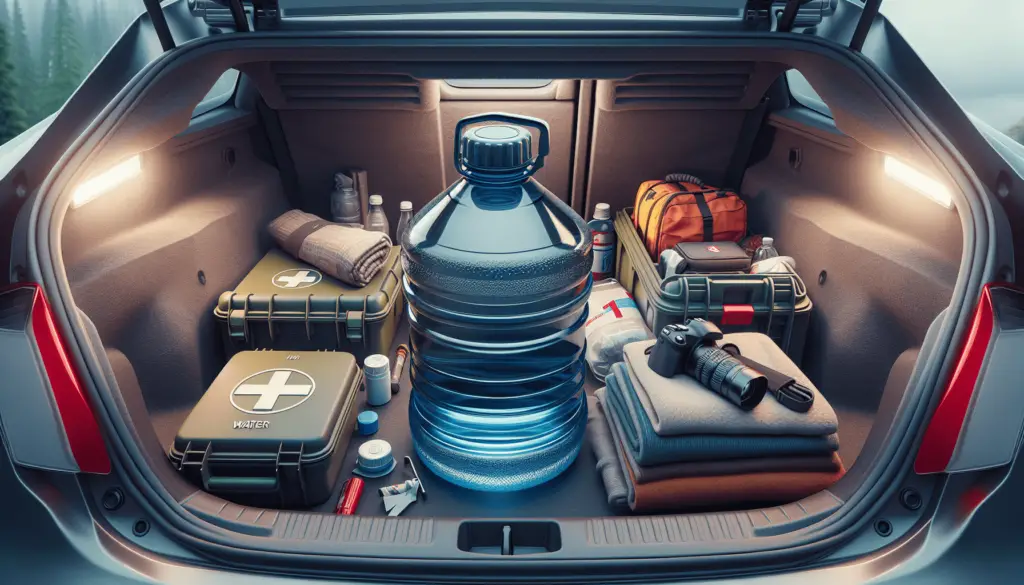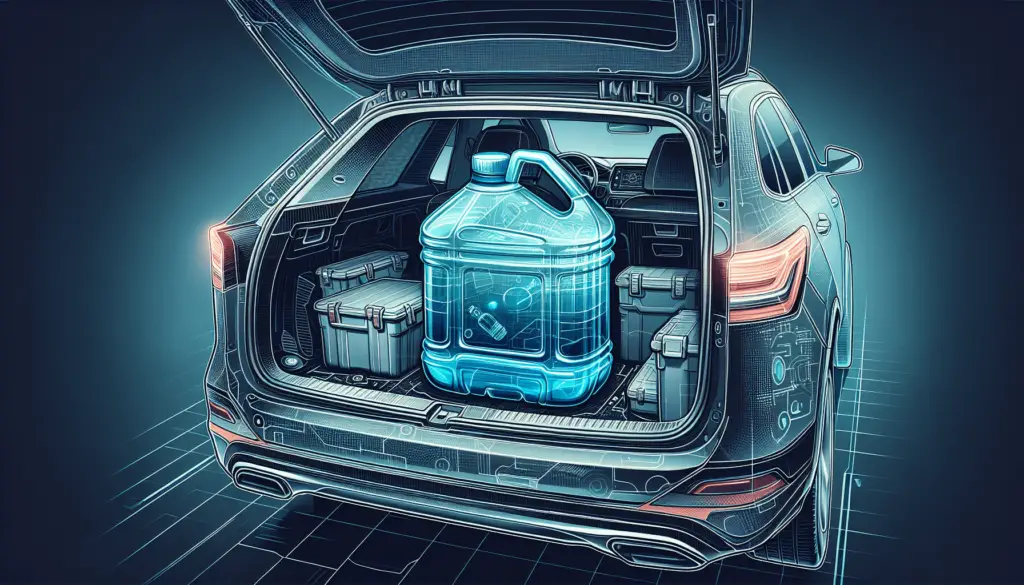Imagine you are embarking on a thrilling road trip, exploring new places and creating unforgettable memories. As you hit the road, it’s essential to be prepared for any unexpected situations that may arise. One of the most crucial aspects of being prepared is having access to clean and safe drinking water, especially when you are on the go. In this article, we will explore the best methods on how to safely store water in your vehicle, ensuring that you are well-equipped for your adventures ahead.
Choosing the Right Containers
When it comes to storing water, choosing the right containers is crucial. Two popular options are plastic and metal containers. Plastic containers are lightweight, easy to transport, and generally affordable. On the other hand, metal containers are more durable and resistant to impact. Consider your specific needs and preferences when deciding between plastic and metal containers.
In addition to the material, make sure that the containers you choose are food-grade. This means that they are made with materials that are safe for storing food and water. Look for containers that are specifically labeled as food-grade to ensure that your water remains clean and uncontaminated.
Another important factor to consider is the lid of the containers. A secure lid is essential to prevent any leakage or contamination. Opt for containers with tight-fitting lids that are easy to open and close. This will help protect your water supply and keep it safe for consumption.
Cleaning and Disinfecting Containers
Before storing water in your chosen containers, it is crucial to thoroughly wash them. Use warm water and a mild dish soap to clean the containers, ensuring that all dirt and residue are removed. Pay close attention to any crevices or corners where bacteria or mold could accumulate.
After washing, it is recommended to disinfect the containers using a mild bleach solution. Mix 1 teaspoon of bleach per 1 gallon of water, and use this solution to wipe down the containers both inside and out. Allow the bleach solution to sit for a few minutes before rinsing it off with clean water.
Once the containers have been cleaned and disinfected, allow them to air dry completely before storing water inside. This will help prevent any residual moisture that could lead to bacterial growth or contamination.

Considering Water Treatment Options
While storing water, it is important to consider water treatment options to ensure the water remains safe and suitable for consumption. One option is to use water purification tablets or drops. These compact and easy-to-use products can effectively eliminate harmful bacteria and viruses from the water. Follow the instructions on the packaging for the recommended dosage and treatment time.
Another option to consider is portable water filters. These filters are designed to remove impurities and contaminants from water, making it safe to drink. Look for filters that are specifically designed for outdoor or emergency use, as they are typically more efficient in removing bacteria and other harmful substances.
Finding Suitable Storage Locations
When storing water, it is important to choose the right locations to ensure the quality and longevity of your water supply. Avoid storing containers in direct sunlight, as exposure to UV rays can degrade the quality of the water over time. Instead, opt for cool and well-ventilated spaces, such as a basement or pantry, where the temperature remains relatively stable.
To prevent any movement or potential damage, securely anchor your containers in place. This can be done by using straps, bungee cords, or shelving units specifically designed for water storage. By securing your containers, you can minimize the risk of accidents and ensure that your water remains intact.

Monitoring and Rotation of Water Supply
Regularly checking your water storage containers is essential to identify any leaks or damage. Inspect the containers for cracks, tears, or any signs of wear and tear. If you notice any issues, promptly replace the damaged containers to prevent any contamination or loss of water.
In addition to monitoring, it is important to rotate your water supply every few months. By doing so, you can ensure that the water remains fresh and of high quality. Simply use and replace the stored water with fresh water, allowing for a continuous rotation cycle.
Emergency Storage Solutions
In emergency situations, it is important to have alternative storage solutions to ensure an adequate water supply. One option is to store bottled water in your emergency kits. Purchase commercially sealed bottled water that has a long shelf life and store it in a designated emergency kit, ensuring easy access during times of need.
Another solution to consider is collapsible water storage bags. These bags are compact and can be easily stored when not in use. When needed, simply fill them with water and secure the cap or seal. Collapsible water storage bags are especially useful for outdoor activities or situations where space is limited.
Individual water pouches are also a convenient option for emergency storage. These pouches typically contain around 4.2 ounces of water and are easy to store in small spaces. They are designed for single-use and provide a compact and portable solution for emergency hydration.
Additional Considerations for Extreme Temperatures
Extreme temperatures can affect the quality and safety of your stored water. Avoid freezing water in containers, as the freezing process can cause the containers to crack or rupture. Instead, store water in a temperature-controlled environment to prevent any damage.
In cold weather conditions, it is recommended to insulate your water storage containers to prevent freezing. Wrap the containers with insulating materials, such as foam or blankets, to minimize heat loss and maintain a stable temperature.
In hot weather, consider using reflective covers or materials to shield your water storage containers from direct sunlight. Exposure to prolonged sunlight can raise the temperature of the water, potentially degrading its quality. By using reflective covers, you can help regulate the temperature and protect your water supply.
Water Storage for Outdoor Activities
If you enjoy outdoor activities, it is important to have suitable water storage systems. Portable water storage systems, such as hydration packs or collapsible water bottles, are designed to be lightweight and easy to carry. They allow you to conveniently carry and access water while on the move.
Insulated water bottles are another option to consider for outdoor activities. These bottles are designed to maintain the temperature of your water, keeping it cool in hot weather and preventing freezing in cold weather. Insulated water bottles also often have a durable construction, making them suitable for outdoor adventures.
Emergency Preparedness Tips
In order to be fully prepared for emergencies, it is important to have emergency water storage guidelines. These guidelines should include the recommended amount of water to store, the storage duration, and proper rotation practices. Familiarize yourself with these guidelines and ensure that everyone in your household is aware of them.
Additionally, take the time to educate yourself on water filtration and purification methods. Understanding how to effectively treat water in emergency situations will further enhance your preparedness. Research different water filters, purifiers, and treatment methods, keeping in mind their pros and cons in various scenarios.
Regularly Review and Maintain Water Storage
Water storage is not a one-time task; it requires regular review and maintenance. Check the expiration dates of any water treatment products you have, such as purification tablets or drops, and make sure to replenish them accordingly. Expired products may not be effective in treating water and could compromise its safety.
Periodically clean and refresh your water supply to maintain its quality. Empty and clean your containers at least once every six months, even if the water has not been consumed. This will help prevent any potential buildup of bacteria or mold and ensure that your stored water remains safe for consumption.
By following these guidelines and incorporating them into your water storage routine, you can ensure the safety and availability of clean water in times of need. Remember, proper water storage is an essential aspect of emergency preparedness and can greatly contribute to your well-being and peace of mind.
